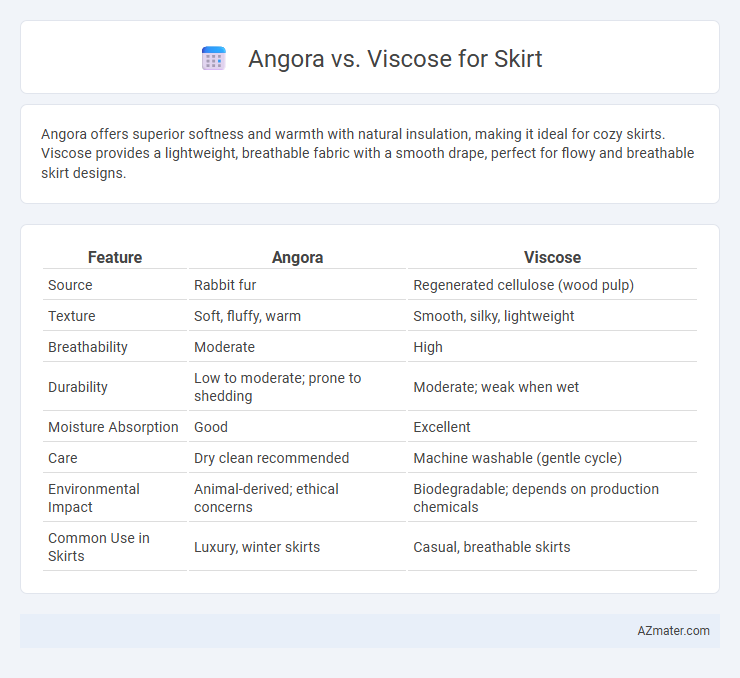Angora offers superior softness and warmth with natural insulation, making it ideal for cozy skirts. Viscose provides a lightweight, breathable fabric with a smooth drape, perfect for flowy and breathable skirt designs.
Table of Comparison
| Feature | Angora | Viscose |
|---|---|---|
| Source | Rabbit fur | Regenerated cellulose (wood pulp) |
| Texture | Soft, fluffy, warm | Smooth, silky, lightweight |
| Breathability | Moderate | High |
| Durability | Low to moderate; prone to shedding | Moderate; weak when wet |
| Moisture Absorption | Good | Excellent |
| Care | Dry clean recommended | Machine washable (gentle cycle) |
| Environmental Impact | Animal-derived; ethical concerns | Biodegradable; depends on production chemicals |
| Common Use in Skirts | Luxury, winter skirts | Casual, breathable skirts |
Introduction: Angora vs Viscose for Skirts
Angora fibers, derived from the Angora rabbit, offer exceptional warmth, softness, and a luxurious texture ideal for cozy skirts. Viscose, a semi-synthetic fiber made from cellulose, provides a smooth, breathable fabric with excellent drape, perfect for lightweight and flowy skirt designs. Comparing Angora and Viscose for skirts highlights a choice between natural warmth and plushness versus breathable comfort and ease of care.
Composition and Source: Angora and Viscose Explained
Angora fabric is derived from the soft, fine hair of Angora rabbits, offering natural warmth and a luxurious texture ideal for skirts. Viscose, a semi-synthetic fiber made from regenerated cellulose sourced primarily from wood pulp, provides a smooth, lightweight, and breathable alternative with excellent drape. The difference in composition affects durability and care, with Angora being more delicate and prone to shedding, while viscose balances softness with easy maintenance.
Texture and Feel: Comfort Comparison
Angora offers a plush, soft texture with exceptional warmth, making skirts feel cozy and luxurious against the skin. Viscose provides a smooth, silky feel that drapes elegantly and breathes well, enhancing comfort in warmer conditions. For a skirt, Angora suits cooler climates with its insulating properties, whereas Viscose excels in softness and moisture absorption, ensuring comfort in milder temperatures.
Breathability and Moisture Management
Angora fibers offer excellent breathability due to their natural hollow structure, allowing air circulation and temperature regulation in skirts. Viscose, derived from cellulose, provides moderate moisture management by absorbing sweat and quickly releasing it, keeping the fabric dry. Combining Angora's warmth with Viscose's moisture-wicking properties creates skirts that balance comfort and breathability in various climates.
Durability and Longevity
Angora fibers offer exceptional durability due to their natural resilience and elasticity, making skirts resistant to wear and tear over time. Viscose, derived from cellulose, tends to be less durable as it is prone to weakening when exposed to moisture and frequent washing. For long-lasting skirts, Angora provides superior longevity, maintaining its softness and structural integrity better than viscose.
Warmth and Seasonal Suitability
Angora fibers provide superior warmth due to their natural insulation properties, making skirts crafted from Angora ideal for cold winter months. Viscose, derived from cellulose, offers breathability and moisture absorption, which suits skirts better for milder temperatures in spring and fall. Choosing between Angora and Viscose for skirts depends on the desired warmth level and the seasonal context in which the garment will be worn.
Sustainability and Eco-Friendliness
Angora fibers are biodegradable and renewable, making them a sustainable choice for skirts when ethically sourced from humane rabbit farming that avoids animal cruelty. Viscose, derived from cellulose, poses environmental concerns due to chemical-intensive production that can pollute waterways unless produced via eco-friendly closed-loop processes. Opting for certified organic Angora supports animal welfare and reduces carbon footprint, whereas eco-certified viscose offers a more sustainable alternative to conventional synthetics if strict environmental standards are met.
Maintenance and Care Instructions
Angora skirts require gentle hand washing or dry cleaning to prevent fiber damage and maintain softness, avoiding hot water and harsh detergents. Viscose skirts are best cared for by washing in cold water with mild detergent, ideally on a delicate cycle or hand washing, and should be air-dried to prevent shrinkage and fabric distortion. Storing Angora garments in a cool, dry place with moth repellents protects against damage, while viscose benefits from folding rather than hanging to avoid stretching.
Price and Accessibility
Angora skirts tend to be more expensive due to the labor-intensive process of harvesting fine rabbit fibers, making them a premium choice often found in specialty boutiques or online luxury retailers. Viscose skirts offer a more affordable alternative with widespread availability in mainstream fashion stores and online marketplaces, catering to budget-conscious shoppers. The higher cost of angora is balanced by its unique softness and warmth, while viscose provides versatility and ease of maintenance at a lower price point.
Best Choice: Which Fabric Wins for Skirts?
Angora offers exceptional warmth and softness, making it ideal for winter skirts, while viscose provides breathability and a silky texture suited for lighter, flowy designs. Angora's natural insulation excels in cold climates, whereas viscose excels in moisture absorption and drapes beautifully for warm weather skirts. Choosing between Angora and viscose depends on seasonality and desired skirt style, with Angora dominating in warmth and viscose preferred for comfort and versatility.

Infographic: Angora vs Viscose for Skirt
 azmater.com
azmater.com